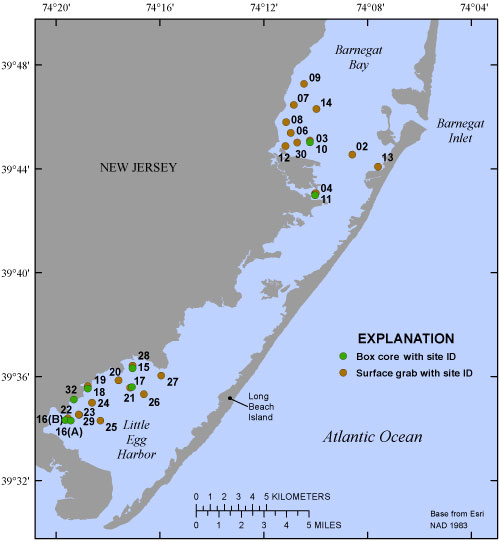Data Series 993
| Field Data CollectionUSGS SPCMSC scientists collected estuarine bottom sediment from two areas within Barnegat Bay, New Jersey, during May 12-14, 2014, aboard the Rutgers University R/V Caleta (USGS Field Activity Number [FAN] 2014-310-FA). Sediment samples were collected at 11 sites near Barnegat Inlet in the central portion of the bay and 11 sites in Little Egg Harbor in the southern portion of the bay. A surficial sediment grab sample was collected at each site, with the exception of sites 14BRN-16(A) and 14BRN-32, using a Wildco Petite Ponar sampler. Upon retrieval, the overlying water was drained and the upper 1 centimeter (cm) of sediment was sampled for sediment characterization and micropaleontology. Water-quality parameters were measured at each sampling site with a YSI Professional Plus multi-sensor meter at a depth of 1 meter below the water surface. Site coordinates were recorded on a hand-held Garmin GPSMAP 62stc Global Positioning (GPS) receiver. In addition to the Ponar grab samples, a box core was collected at eight of the sampling sites (fig. 2), two near Barnegat Inlet and six in Little Egg Harbor. A 30- x 45-cm box corer capable of retrieving the upper 55 cm of bottom sediment was operated using an A-frame winch. Following deployment and sediment collection, the box core was brought onboard and stabilized in a steel stand. The overlying water was drained, and the sediment surface was visually inspected. If the sediment surface showed signs of disturbance, the sediment was discarded and another box core was collected. Each satisfactory box core was subsampled using a 15.2-cm diameter polycarbonate barrel as well as a 7.6-cm diameter polycarbonate barrel. After inserting the two barrels, the upper 1 cm of surrounding sediment was sampled for sediment characterization and micropaleontology. The two barrels were carefully removed from the box corer and capped. The cores were maintained in a vertical position so the sediment profile remained undisturbed. Box cores were attempted at sites 01, 02, 05, 08, and 17 (fig. 2); however, the sediment was too compacted for penetration even with the addition of 200 pounds of lead weights attached to the box corer. The 15.2-cm diameter cores were sectioned in the field within 2 days of collection. The cores were vertically extruded and sliced into 1-cm intervals. Each interval was subsampled for sediment characterization, radiochemistry, and micropaleontology. The sediment characterization/radiochemistry splits were chilled during shipment to the SPCMSC laboratory. The 7.6-cm diameter cores were shipped intact to the SPCMSC laboratory.
 Figure 2. Sediment sampling locations in Barnegat Bay and Little Egg Harbor, May 12–14, 2014. [Click to enlarge] |